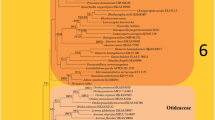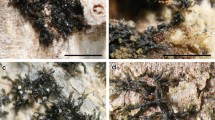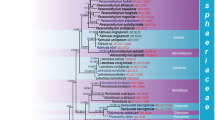Abstract
The monotypic genus Umbellidion remains as an incertae sedis in Pezizomycotina. This saprotrophic anamorphic fungus is morphologically distinct and unique, occurring widely in Brazil on several hosts, with only one record in the Caribbean region. During the project “Microfungi from Brazil: looking for new species,” five strains of U. radulans were obtained from decaying leaves of Eucalyptus spp., in the Floresta Estadual Edmundo Navarro de Andrade (FEENA), Rio Claro, São Paulo state, Brazil, and were studied based on their morphology and phylogeny. In this study, we conducted a multigene phylogenetic analysis based on ITS, LSU, SSU, TEF1, and RPB2 sequences of 78 related taxa of Leotiomycetes. Phylogenetic inference showed that strains of Umbellidion form a unique, statistically supported lineage near the base of the Leotiomycetes. Accordingly, a new taxonomic order and family Umbellidiales and Umbellidiaceae were established to classify U. radulans. In addition, U. radulans is epitypified based on a new specimen collected from a Eucalyptus grandis plantation in Brazil.


Similar content being viewed by others
Data availability
DNA sequences are available in GenBank and alignments were deposited on Figshare.
Code availability
Not applicable.
References
Ariyawansa HA, Hawkworth DL, Hyde KD, Gareth Jones EB, Maharachchikumbura SSN, Manamgoda DS, Thambugala KM, Udayanga D, Camporesi E, Daranagama A, Jayawardena R, Liu JK, McKenzie EHC, Phookamsak R, Senanayake IC, Shivas RG, Tian Q, Xu JC (2014) Epitypification and neotypification: guidelines with appropriate and inappropriate examples. Fungal Divers 69:57–91. https://doi.org/10.1007/s13225-014-0315-4
Baral H-O, de Sloover J, Huhtinen S, Laukka T, Stenroos S (2009) An emendation of the genus Hyaloscypha to include Fuscoscypha (Hyaloscyphaceae, Helotiales, Ascomycotina). Karstenia 49(1):1–17. https://doi.org/10.29203/ka.2009.430
Barbosa FR, Maia LC, Gusmão LFP (2009) Fungos conidiais associados ao folhedo de Clusia melchiorii Gleason e C. nemorosa G. Mey. (Clusiaceae) em fragmento de Mata Atlântica, BA, Brasil. Acta Bot Bras 23(1):79–84. https://doi.org/10.1590/s0102-33062009000100010
Barbosa FR, Raja HA, Shearer CA, Gusmão LFP (2013) Some freshwater fungi from the Brazilian semi-arid region, including two new species of hyphomycetes. Cryptogam Mycol 34(3):243–258. https://doi.org/10.7872/crym.v34.iss2.2013.243
Baschien C, Tsui CKM, Gulis V, Szewzyk U, Marvanová L (2013) The molecular phylogeny of aquatic hyphomycetes with affinity to the Leotiomycetes. Fungal Biol 117(9):660–672. https://doi.org/10.1016/j.funbio.2013.07.004
Baschien CM, Marvanova L, Szewzyk U (2006) Phylogeny of selected aquatic hyphomycetes based on morphological and molecular data. Nova Hedwigia 83(3–4):311–352. https://doi.org/10.1127/0029-5035/2006/0083-0311
Castañeda-Ruiz RF, Heredia G, Gusmão LPF, De-Wei L (2016) Fungal diversity of Central and South America. In: Li D-W (ed) Biol. of Microfungi. Springer International Publishing AG, Switzerland, pp 197–217. https://doi.org/10.1007/978-3-319-29137-6_9
Crous PW, Braun U, Wingfield MJ, Wood AR, Shin HD, Summerell BA, Alfenas AC, Cumagun CJ, Groenewald JZ (2009) Phylogeny and taxonomy of obscure genera of microfungi. Persoonia 22(1):139–161. https://doi.org/10.3767/003158509x461701
Crous PW, Quaedvlieg W, Hansen K, Hawksworth DL, Groenewald JZ (2014) Phacidium and Ceuthospora (Phacidiaceae) are congeneric: taxonomic and nomenclatural implications. IMA Fungus 5(2):173–193. https://doi.org/10.5598/imafungus.2014.05.02.02
Crous PW, Wingfield MJ, Burgess TI, Carnegie AJ, Hardy SJ, GE SD, Summerell BA, Cano-Lira JF, Guarro J, Houbraken J, Lombard L, Martín MP, Sandoval-Denis M, Alexandrova AV, Barnes CW, Baseia IG, JDP B, Guarnaccia V, May TW et al (2017) Fungal planet description sheets: 625–715. Persoonia 39(2):70–467. https://doi.org/10.3767/persoonia.2017.39.11
Crous PW, Wingfield MJ, Cheewangkoon R, Carnegie AJ, Burgess T, Summerel BA, Edwards J, Taylor PWJ, Groenewald JZ (2019) Foliar pathogens of eucalypts. Stud Mycol 94:125–298. https://doi.org/10.1016/j.simyco.2019.08.001
Damm U, Fourie PH, Crous PW (2010) Coniochaeta (Lecythophora), Collophora gen. nov. and Phaeomoniella species associated with wood necroses of Prunus trees. Persoonia 24:60–80. https://doi.org/10.3767/003158510x500705
de Hoog G, Gottlich E, Platas G, Genilloud O, Leotta G, van Brummelen J (2005) Evolution, taxonomy and ecology of the genus Thelebolus in Antarctica. Stud Mycol 51:33–76
Ekanayaka AH, Hyde KD, Gentekaki E, McKenzie EHC, Zhao Q, Bulgakov TS, Camporesi E (2019) Prelim Classification Leotiomycetes Mycosphere 10(1):310–489. https://doi.org/10.5943/mycosphere/10/1/7
Eriksson OE, Winka K (1997) Supraordinal taxa of Ascomycota. Myconet 1:1–16
Ge Z-W, Yang ZL, Pfister DH, Carbone M, Bau T, Smith ME (2014) Multigene molecular phylogeny and biogeographic diversification of the earth tongue fungi in the genera Cudonia and Spathularia (Rhytismatales, Ascomycota). PLoS One 9(8):e103457. https://doi.org/10.1371/journal.pone.0103457
Haelewaters D, Park D, Johnston PR (2021) Multilocus phylogenetic analysis reveals that Cyttariales is a synonym of Helotiales. Mycol Prog 20(10):1323–1330. https://doi.org/10.1007/s11557-021-01736-2
Hall TA (1999) BioEdit: a user-friendly biological sequence alignment editor and analysis program for Windows 95/98/NT. Nucleic Acids Symp Ser 41:95–98
Han J-G, Hosoya T, Sung G-H, Shin H-D (2014) Phylogenetic reassessment of Hyaloscyphaceae sensu lato (Helotiales, Leotiomycetes) based on multigene analyses. Fungal Biol 118(2):150–167. https://doi.org/10.1016/j.funbio.2013.11.004
Hawksworth DL, Lücking R (2017) Fungal diversity revisited: 2.2 to 3.8 million species. Microbiol Spectr 5(4):1–17. https://doi.org/10.1128/microbiolspec.funk-0052-2016
Hernández-Restrepo M, Gené J, Castañeda-Ruiz RF, Mena-Portales J, Crous PW, Guarro J (2017) Phylogeny of saprobic microfungi from Southern Europe. Stud Mycol 86:53–97. https://doi.org/10.1016/j.simyco.2017.05.002
Hernández-Restrepo M, Gené J, Mena-Portales J, Cano J, Madrid H, Castañeda-Ruiz RF, Guarro J (2014) New species of Cordana and epitypification of the genus. Mycol 106(4):723–734. https://doi.org/10.3852/13-122
Hoang DT, Chernomor O, von Haeseler A, Minh BQ, Vinh LS (2018) UFBoot2: improving the ultrafast bootstrap approximation. Mol Biol Evol 35:518–522. https://doi.org/10.1093/molbev/msx281
Hosoya T, Han J-G, Sung G-H, Hirayama Y, Tanaka K, Hosaka K, Tanaka I, Shin H-D (2010) Molecular phylogenetic assessment of the genus Hyphodiscus with description of Hyphodiscus hyaloscyphoides sp. nov. Mycol Prog 10(2):239–248. https://doi.org/10.1007/s11557-010-0693-2
Hou C-L, Trampe T, Piepenbring M (2010) A new species of Rhytisma causes tar spot on Comarostaphylis arbutoides (Ericaceae) in Panama. Mycopathologia 169(3):225–229. https://doi.org/10.1007/s11046-009-9250-4
Hyde KD, Zhang Y (2008) Epitypification: should we epitypify? J Zhejiang Univ Sci B 9:842–846. https://doi.org/10.1631/jzus.B0860004
Izabel TSS, Santos DS, Almeida DAC, Gusmão LFP (2011) Fungos conidiais do bioma Caatinga II. Novos registros para o continente americano, Neotrópico, América do Sul e Brasil. Rodriguésia 62(2):229–240. https://doi.org/10.1590/2175-7860201162201
Johnston PR, Baschien C (2020) Tricladiaceae fam. nov. (Helotiales, Leotiomycetes). Fungal Syst and Evol 6(1):233–242. https://doi.org/10.3114/fuse.2020.06.10
Johnston PR, Park D (2005) Chlorociboria (Fungi, Helotiales) in New Zealand. N Z J of Bot 43(3):679–719. https://doi.org/10.1080/0028825x.2005.9512985
Johnston PR, Park D (2019) New species of Marthamyces and Ramomarthamyces gen. nov. from New Zealand and the Cook Islands. Mycotaxon 134(3):489–516. https://doi.org/10.5248/134.489
Johnston PR, Park D (2022) Hymenotorrendiella clelandii (Leotiomycetes, Helotiales, Helotiaceae) and related species from Australia and New Zealand. N Z J of Bot https://doi.org/10.1080/0028825x.2022.2052914
Johnston PR, Park D, Smith ME, Mujic AB, May TW (2021) Brahmaculus gen. nov. (Leotiomycetes, Chlorociboriaceae). MycoKeys 80:19–43. https://doi.org/10.3897/mycokeys.80.64435
Johnston PR, Quijada L, Smith CA, Hans-Otto B, Hosoya T, Baschien C, Pärtel K, Zhuang WY, Haelewaters D, Park D, Carl S, López-Giráldez F, Wang Z, Townsend JP (2019) A multigene phylogeny toward a new phylogenetic classification of Leotiomycetes. IMA Fungus 10(1):1–22. https://doi.org/10.1186/s43008-019-0002-x
Kalyaanamoorthy K, Minh BQ, Wong TKF, von Haeseler A, Jermiin LS (2017) ModelFinder: fast model selection for accurate phylogenetic estimates. Nat Methods 14:587–589. https://doi.org/10.1038/nmeth.4285
Karakehian JM, Quijada L, Friebes G, Tanney JB, Pfister DH (2019) Placement of Triblidiaceae in Rhytismatales and comments on unique ascospore morphologies in Leotiomycetes (Fungi, Ascomycota). MycoKeys 54:99–133. https://doi.org/10.3897/mycokeys.54.35697
Karunarathna A, Peršoh D, Ekanayaka AH, Jayawardena RS, Thilini Chethana KW, Goonasekara ID, Goonasekara ID, Cheewangkoon R, Camporesi E, Hyde KD, Lumyong S, Karunarathna SC (2020) Patellariopsidaceae fam. nov. with sexual-asexual connection and a new host record for Cheirospora botryospora (Vibrisseaceae, Ascomycota). Front Microbiol 11:906. https://doi.org/10.3389/fmicb.2020.00906
Katoh K, Kei-ichi K, Toh H, Miyata T (2005) MAFFT version 5: improvement in accuracy of multiple sequence alignment. Nucleic Acids Res 33(2):511–518. https://doi.org/10.1093/nar/gki198
Katoh K, Standley DM (2013) MAFFT multiple sequence alignment software version 7: improvements in performance and usability. Mol Biol Evol 30:772–780
Kumar S, Stecher G, Tamura K (2016) MEGA7: molecular evolutionary genetics analysis version 7.0 for bigger datasets. Mol Biol Evol 33:1870–1874. https://doi.org/10.1093/molbev/msw054
Lacerda LT, Gusmão LFP, Rodrigues A (2018) Diversity of endophytic fungi in Eucalyptus microcorys assessed by complementary isolation methods. Mycol Prog 17(6):719–727. https://doi.org/10.1007/s11557-018-1385-6
Lacerda LT, Gusmão LFP, Rodrigues A (2019) Fungal communities in different aged leaves of Eucalyptus microcorys F. Muell. Braz J of Bot 42(3):499–508. https://doi.org/10.1007/s40415-019-00557-8
Liu YJ, Whelen S, Hall BD (1999) Phylogenetic relationships among ascomycetes: evidence from an RNA polymerase II subunit. Mol Biol Evol 16:1799–1808. https://doi.org/10.1093/oxfordjournals.molbev.a026092
Maciá-Vicente JG, Piepenbring M, Koukol O (2020) Brassicaceous roots as an unexpected diversity hot-spot of helotialean endophytes. IMA Fungus 11:16. https://doi.org/10.1186/s43008-020-00036-w
Marques MFO, Gusmão LFP, Maia LC (2008) Riqueza de espécies de fungos conidiais em duas áreas de Mata Atlântica no Morro da Pioneira, Serra da Jibóia, BA Brasil. Acta Bot Bras 22(4):954–961. https://doi.org/10.1590/s0102-33062008000400006
Miller MA, Pfeiffer W, Schwartz T (2010) Creating the CIPRES Science Gateway for inferences of large phylogenetic trees. Proc Gateway Comp Environ Workshop 14:1–8. https://doi.org/10.1109/GCE.2010.5676129
Minnis AM, Lindner DL (2013) Phylogenetic evaluation of Geomyces and allies reveals no close relatives of Pseudogymnoascus destructans, comb. nov., in bat hibernacula of eastern North America. Fungal Biol 117(9):638–649. https://doi.org/10.1016/j.funbio.2013.07.001
Minter DW, Rodríguez-Hernández M, Mena-Portales J (2001) Checklist of the Caribbean Fungi. In Minter DW, Rodríguez-Hernández M, Mena-Portales J (eds) Fungi of the Caribbean: An annotated checklist. PMDS Publisher, pp 718–743
Nguyen LT, Schmidt HA, von Haeseler A, Minh BQ (2015) IQ-TREE: a fast and effective stochastic algorithm for estimating maximum likelihood phylogenies. Mol Biol Evol 32:268–274. https://doi.org/10.1093/molbev/msu300
Paithankar KR, Prasad KSN (1991) Precipitation of DNA by polyethylene glycol and ethanol. Nucleic Acids Res 19(6):1346. https://doi.org/10.1093/nar/19.6.1346
Pärtel K, Baral H-O, Tamm H, Põldmaa K (2016) Evidence for the polyphyly of Encoelia and Encoelioideae with reconsideration of respective families in Leotiomycetes. Fungal Divers 82(1):183–219. Available from: https://doi.org/10.1007/s13225-016-0370-0
Peterson KR, Pfister DH (2010) Phylogeny of Cyttaria inferred from nuclear and mitochondrial sequence and morphological data. Mycol 102(6):1398–1416. https://doi.org/10.3852/10-046
Phukhamsakda C, McKenzie EHC, Phillips AJL, Gareth Jones EB, Jayarama Bhat D, Stadler M, Bhunjun CS, Wanasinghe DN, Thongbai B, Camporesi E, Ertz D, Jayawardena RS, Perera RH, Ekanayake AH, Tibpromma S, Doilom M, Xu J, Hyde KD (2020) Microfungi associated with Clematis (Ranunculaceae) with an integrated approach to delimiting species boundaries. Fungal Divers 102(1):1–203. https://doi.org/10.1007/s13225-020-00448-4
Prieto M, Schultz M, Olariaga I, Wedin M (2018) Lichinodium is a new lichenized lineage in the Leotiomycetes. Fungal Divers 94(1):23–39. https://doi.org/10.1007/s13225-018-0417-5
Quijada L, Matočec N, Kušan I, Tanney JB, Johnston PR, Mešić A, Pfister DH (2022) Apothecial ancestry, evolution, and re-evolution in Thelebolales (Leotiomycetes, Fungi). Biol 11(4):583. https://doi.org/10.3390/biology11040583
Quijada L, Tanney JB, Popov E, Johnston PR, Pfister DH (2020) Cones, needles and wood: Micraspis (Micraspidaceae, Micraspidales fam. et ord. nov.) speciation segregates by host plant tissues. Fungal Syst Evol 5:99–111. https://doi.org/10.3114/fuse.2020.05.05
Rambaut A (2012) FigTree version 1.4.0. Available at http://tree.bio.ed.ac.uk/software/figtree. Accessed 14 Nov 2022
Rehner S, Buckley E (2005) A Beauveria phylogeny inferred from nuclear ITS and EF1-α sequences: evidence for cryptic diversification and links to Cordyceps teleomorphs. Mycol 97:84–98. https://doi.org/10.3852/mycologia.97.1.84
Rossman AY, Cathie AM, Farr DF, Castlebury LA, Peterson KR, Leahy R (2004) The coelomycetous genera Chaetomella and Pilidium represent a newly discovered lineage of inoperculate discomycetes. Mycol Prog 3(4):275–290. https://doi.org/10.1007/s11557-006-0098-4
Schoch CL, Sung G-H, López-Giráldez F, Townsend JP, Miadlikowska J, Hofstetter V, Robbertse B, Matheny PB, Kauff F, Wang Z, Gueidan C, Andrie RM, Trippe K, Ciufetti LM, Wynns A, Fraker E, Hodkinson BP, Bonito G, Groenewald JZ et al (2009) The Ascomycota tree of life: a phylum-wide phylogeny clarifies the origin and evolution of fundamental reproductive and ecological traits. Syst Biol 58(2):224–239. https://doi.org/10.1093/sysbio/syp020
Sennikov AN (2022) The concept of epitypes in theory and practice. Nor J Bot 8:1–4. https://doi.org/10.1111/njb.03535
Slippers B, Stenlid J, Wingfield MJ (2005) Emerging pathogens: fungal host jumps following anthropogenic introduction. Trends Ecol Evol 20(8):420–421. https://doi.org/10.1016/j.tree.2005.05.002
Solheim H, Torp TB, Hietala AM (2012) Characterization of the ascomycetes Therrya fuckelii and T. pini fruiting on Scots pine branches in Nordic countries. Mycol Prog 12(1):37–44. https://doi.org/10.1007/s11557-012-0813-2
Somrithipol S, Jones EBG, Bahkali AH, Suetrong S, Sommai S, Chamoi C, Johnston PR, Cooper JA, Rungjindamai N (2017) Lauriomyces, a new lineage in the Leotiomycetes with three new species. Cryptogam Mycol 38(2):259–273. https://doi.org/10.7872/crym/v38.iss2.2017.259
Spatafora JW, Sung G-H, Johnson D, Hesse C, O’Rourke B, Serdani M, Spotts R, Lutzoni F, Hofstetter V, Miadlikowska J, Reeb V, Gueidan C, Fraker E, Lumbsch T, Lücking R, Schmitt I, Hosaka K, Aptroot A, Roux C et al (2006) A five-gene phylogeny of Pezizomycotina. Mycol 98(6):1018–1028. https://doi.org/10.3852/mycologia.98.6.1018
Sutton BC (1975) Eucalyptus microfungi: Satchmopsis gen. nov. and new species of Coniella, Coniothyrium and Harknessia. Nova Hedwigia 26(1):1–16
Sutton BC, Hodges CS (1975a) Eucalyptus microfungi: Codinaea and Zanclospora species from Brazil. Nova Hedwigia 26:517–525
Sutton BC, Hodges CS (1975b) Eucalyptus microfungi: two new hyphomycete genera from Brazil. Nova Hedwigia 26:527–533
Sutton BC, Hodges CS (1976a) Eucalyptus microfungi: some setose hyphomycetes with phialides. Nova Hedwigia 27(1-2):343–352
Sutton BC, Hodges CS (1976b) Eucalyptus microfungi: Microdochium and Phaeoisaria species from Brazil. Nova Hedwigia 27:215–222
Sutton BC, Hodges CS (1977) Eucalyptus microfungi: miscellaneous hyphomycetes. Nova Hedwigia 28:487–498
Sutton BC, Hodges CS (1978) Eucalyptus microfungi: Chaetendophragmiopsis gen. nov. and other hyphomycetes. Nova Hedwigia 29:593–607
Tanney JB, Seifert KA (2020) Mollisiaceae: an overlooked lineage of diverse endophytes. Stud Mycol 95:293–380. https://doi.org/10.1016/j.simyco.2020.02.005
Thines M (2019) An evolutionary framework for host shifts – jumping ships for survival. New Phytol 224(2):605–617. https://doi.org/10.1111/nph.16092
Vilgalys R, Hester M (1990) Rapid genetic identification and mapping of enzymatically amplified ribosomal DNA from several Cryptococcus species. J Bacteriol 172(8):4238–4246. https://doi.org/10.1128/jb.172.8.4238-4246.1990
Vilgalys R, Sun BL (1994) Ancient and recent patterns of geographic speciation in the oyster mushroom Pleurotus revealed by phylogenetic analysis of ribosomal DNA sequences. Proc Natl Acad Sci U S A 91(10):4599–4603. https://doi.org/10.1073/pnas.91.10.4599
Voglmayr H, Jaklitsch WM, Tello S (2020) Mycosphaerangium and Neomelanconium (Cenangiaceae) are closest relatives: phylogenetic relationships, morphology and a new species. Mycol Prog 19(11):1329–1352. https://doi.org/10.1007/s11557-020-01630-3
Vu D, Groenewald M, de Vries M, Gehrmann T, Stielow B, Eberhardt U, Al-Hatmi A, Groenewald JZ, Cardinali G, Houbraken J, Boekhout T, Crous PW, Robert V, Verkley GJM (2019) Large-scale generation and analysis of filamentous fungal DNA barcodes boosts coverage for kingdom fungi and reveals thresholds for fungal species and higher taxon delimitation. Stud Mycol 92(1):135–154. https://doi.org/10.1016/j.simyco.2018.05.001
Wang Z, Binder M, Hibbett DS (2005) Life history and systematics of the aquatic discomycete Mitrula (Helotiales, Ascomycota) based on cultural, morphological, and molecular studies. Am J Bot 92(9):1565–1574. https://doi.org/10.3732/ajb.92.9.1565
Wang Z, Binder M, Schoch CL, Johnston PR, Spatafora JW, Hibbett DS (2006) Evolution of helotialean fungi (Leotiomycetes, Pezizomycotina): a nuclear rDNA phylogeny. Mol Phylogenet Evol 41:295–312. https://doi.org/10.1016/j.ympev.2006.05.031
White TJ, Bruns T, Taylor J (1990) Amplification and direct sequencing of fungal ribosomal RNA genes for phylogenetics. In: A guide to molecular methods and 76 applications (Innis MA, Gelfand DH, Sninsky JJ, White JW, eds). Acad Press, pp. 315–322. https://doi.org/10.1016/b978-0-12-372180-8.50042-1
Wijayawardene NN, Hyde KD, Dai DQ, Sánchez-García M, Goto BT, Saxena RK, Erdoğdu M, Selçuk F, Rajeshkumar KC, Aptroot A, Błaszkowski J, Boonyuen N, da Silva GA, de Souza FA, Dong W4, Ertz D, Haelewaters D, EBG J, Karunarathna SC et al (2022) Outline of fungi and fungus-like taxa – 2021. Mycosphere 13(1):53–453. https://doi.org/10.5943/mycosphere/13/1/2
Wilcken CF, Lima ACV, Dias TKR, Masson MV, Filho PJP, Dal Pogetto MHFA (2008) Guia Prático de Manejo de Plantações de Eucalipto. FEPAF, Botucatu
Yilmaz N, Sandoval-Denis M, Lombard L, Visagie CM, Wingfield BD, Crous PW (2021) Redefining species limits in the Fusarium fujikuroi species complex. Persoonia 46:129–162. https://doi.org/10.3767/persoonia.2021.46.05
Zhang Z, Dong C, Chen W, Mou Q, Lu X, Han Y, Huang J, Liang Z (2020) The enigmatic Thelebolaceae (Thelebolales, Leotiomycetes): one new genus Solomyces and five new species. Front Microbiol 11:572596. https://doi.org/10.3389/fmicb.2020.572596
Zhao Y-J, Hosaka K, Hosoya T (2016) Taxonomic re-evaluation of the genus Lambertella (Rutstroemiaceae, Helotiales) and allied stroma-forming fungi. Mycol Prog 15(12):1215–1228. https://doi.org/10.1007/s11557-016-1225-5
Acknowledgements
The authors thank the Conselho Nacional de Desenvolvimento Científico e Tecnológico (CNPq) and Coordenação de Aperfeiçoamento de Pessoal de Nível Superior — Brazil (CAPES, Finance Code 001) for support, and the Programa de Pós-Graduação em Botânica — PPGBOT. The authors also thank Ministério do Meio Ambiente (MMA)/Instituto Chico Mendes de Conservação da Biodiversidade da Biodiversidade (ICMBio) that authorize the expeditions (authorization number: 69462-1), and Instituto Florestal (IF — Governo de São Paulo/Secretaria de Infraestrutura e Meio Ambiente) (authorization number 260108 -004.219/2019). This paper is part of the PhD thesis of the first author.
Funding
This study was financed in part by the Coordenação de Aperfeiçoamento de Pessoal de Nível Superior — Brazil (CAPES, Finance Code 001) and the Conselho Nacional de Desenvolvimento Científico e Tecnológico (CNPq — Proc. 131503/2019-7; Proc. 312984/2018-9).
Author information
Authors and Affiliations
Contributions
G. G. B: formal analysis, investigation, data curation, writing (original draft, review, and editing); J. D. P. B.; D. H. C. de R.: conceptualization and writing; and L.F.P.G.: conceptualization, supervision, project administration, funding acquisition, writing.
Corresponding author
Ethics declarations
Ethics approval
The collection was authorized by the Ministério do Meio Ambiente (MMA)/Instituto Chico Mendes de Conservação da Biodiversidade (ICMBio) (SISBIO number 69462-1) and by Governo de São Paulo/Secretaria de Infraestrutura e Meio Ambiente (authorization number 260108 -004.219/2019).
Consent to participate
Not applicable.
Consent for publication
Not applicable.
Competing interests
The authors declare no competing interests.
Additional information
Section Editor: Hans-Josef Schroers
Publisher’s note
Springer Nature remains neutral with regard to jurisdictional claims in published maps and institutional affiliations.
Rights and permissions
Springer Nature or its licensor (e.g. a society or other partner) holds exclusive rights to this article under a publishing agreement with the author(s) or other rightsholder(s); author self-archiving of the accepted manuscript version of this article is solely governed by the terms of such publishing agreement and applicable law.
About this article
Cite this article
Barreto, G.G., Bezerra, J.D.P., Costa-Rezende, D.H. et al. A multigene phylogeny of Umbellidion revealed a novel lineage in Leotiomycetes. Mycol Progress 22, 48 (2023). https://doi.org/10.1007/s11557-023-01896-3
Received:
Revised:
Accepted:
Published:
DOI: https://doi.org/10.1007/s11557-023-01896-3




